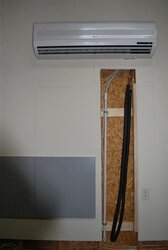Turns out that my utility company will give me a 1200$ rebate for installing one of these. They are ugly but I can see no cheaper way to heat my home when wood heat is unavailable.
So in general, how low from a flat ceiling must the indoor unit set? Higher is better since I want to put something under it like a piece of furniture to try and minimize the visual impact. Is there also a limit to how close something like furniure can be to the bottom?
The indoor unit will be on an interior 2x4 wall. Does the lineset fit/fold up inside the 3.5" cavity or must it poke into the room behind? Do you drill holes into the top of the wall and pass the lineset into the attic? Finally, does the lineset exit the indoor unit from the left or right and is this switchable?
I'll be installing a single 2 ton unit for whole house heating since buying a handful of smaller units seems significantly more complicated and expensive. The smaller units are typically more efficient but only slightly. I am finding that the Fujitsu units (my preference) are rated for heat down to 0 degrees which means that I won't need a backup to this "primary" heat and I can remove some of those wall heaters.
They are ugly like a blaze king but the minisplits are superior performers.
So in general, how low from a flat ceiling must the indoor unit set? Higher is better since I want to put something under it like a piece of furniture to try and minimize the visual impact. Is there also a limit to how close something like furniure can be to the bottom?
The indoor unit will be on an interior 2x4 wall. Does the lineset fit/fold up inside the 3.5" cavity or must it poke into the room behind? Do you drill holes into the top of the wall and pass the lineset into the attic? Finally, does the lineset exit the indoor unit from the left or right and is this switchable?
I'll be installing a single 2 ton unit for whole house heating since buying a handful of smaller units seems significantly more complicated and expensive. The smaller units are typically more efficient but only slightly. I am finding that the Fujitsu units (my preference) are rated for heat down to 0 degrees which means that I won't need a backup to this "primary" heat and I can remove some of those wall heaters.
They are ugly like a blaze king but the minisplits are superior performers.


